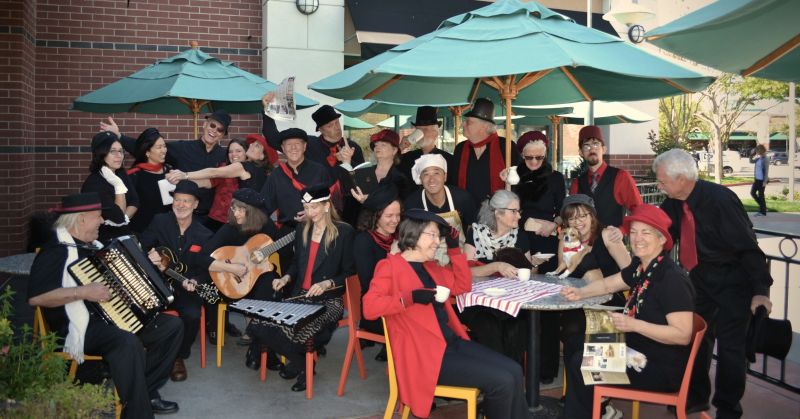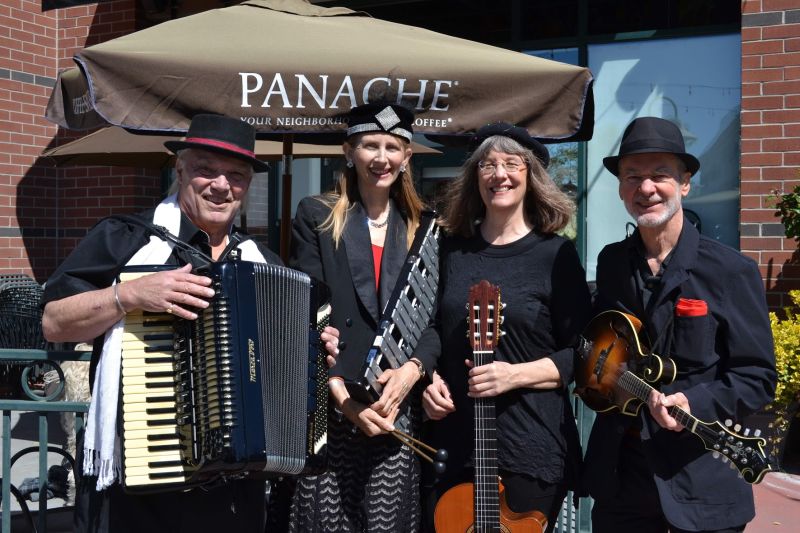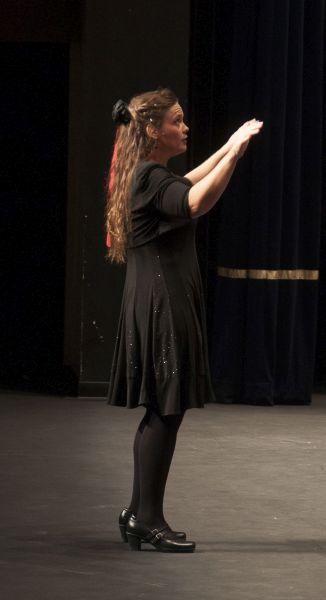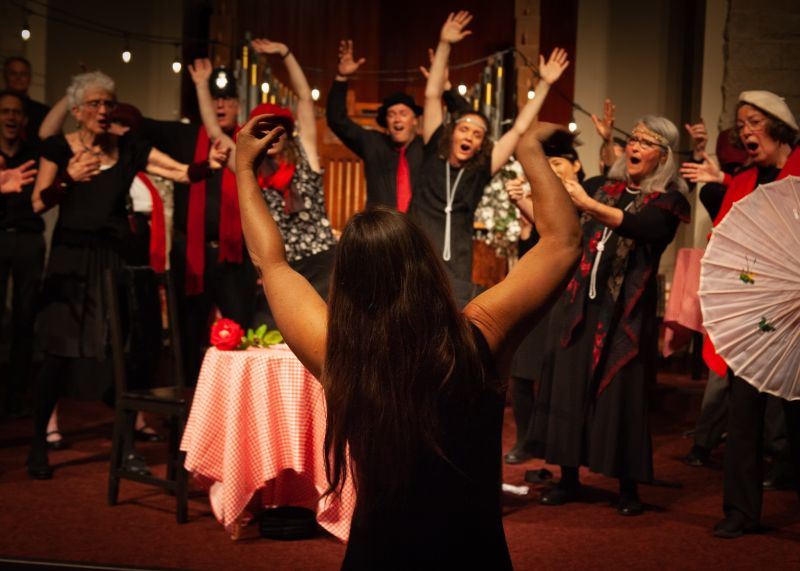Choral Review
Vocal Art Ensemble
C'est La VAE - June 1, 2019
How about a trip to Paris ― not today’s Paris, but the Paris of the 1930s or 1940s? That is what was offered at this concert of the Vocal Art Ensemble on this Saturday evening at the United Methodist Church in Davis.
The Vocal Art Ensemble (VAE) is a mixed chorus with 22 singers under the direction of founder Tracia Barbieri. From their base in Davis, their performances have ranged throughout the Sacramento region and even overseas. I first heard them perform in 2012, and in the 15 or so performances I’ve attended since then, I’ve come to expect the unexpected. Each concert has a theme. Some examples have been: childhood, poetry, food, madrigals, and light. And the musical selections have ranged through a variety of styles, from classical to folk songs, with a strong international emphasis. Three-quarters of the selections in a VAE concert are songs I’ve never heard before, and many are in foreign languages.
The singing is of the highest quality, as I will emphasize below, but there is much more to a VAE concert than the singing. I have witnessed guest dancers, poets, performance artists, and a wide variety of instrumentalists. The audience experience is usually enhanced with costumes, props, and choreography. Most significantly though, the singers give the audience more than their voices: they give emotion that emanates from their faces and gestures in the unique scene set by nearly every song on the program. What they do is explained by these words from the current program: “…blending musical artistry, passion and camaraderie ― to create, to grow, to connect, and to enliven the human experience.”
(Click here to open the program in a new window.)
The guest performers at tonight’s concert were the members of Café Panache, an “acoustic quartet” of accordion (Jim Ewing), mandolin (Rick Palkovic), guitar (Jamie Knapp) and percussion/vocals (Laura Sandage). With the concert set to begin at 7:30, Café Panache began at 7:15 playing “beautiful French songs from the 30s-40s.” They were so good that they got applause from the audience after each selection, and they certainly set the mood for the choral work to follow.
The altar of the church was transformed into “Café de la Rose” with 3 round tables with red checkered tablecloths, a vintage console radio, a couple of coat racks, and other set pieces. At 7:30 Director Tracia Barbieri entered with a cheerful “bon soir,” and she continued speaking a little French, switching to English before non-French-speakers could become uncomfortable. She explained that the scene was a Parisian café from the early 20th century, and that the evening’s program would revolve around 3 love stories, following a script written by Laura Sandage. Laura, incidentally, is the organizer of Café Panache and a multi-talented musician who is always close to the Vocal Art Ensemble, whether or not she is singing with them. Barbieri asked us to refrain from applause until the end of each section of the program, and at this point the 22 singers entered, all dressed differently in outfits suggestive of Paris of a century ago.
 The
story of the first act was one of the ups and downs of two young lovers,
played in pantomime by singers Andrew Hudson and Ashlyn Barbieri. Their
thoughts and dialog were spoken by members of Café Panache, with the
relationship of the two young people evolving between each of the 6
songs of this first set.
The
story of the first act was one of the ups and downs of two young lovers,
played in pantomime by singers Andrew Hudson and Ashlyn Barbieri. Their
thoughts and dialog were spoken by members of Café Panache, with the
relationship of the two young people evolving between each of the 6
songs of this first set.
The singing began with a madrigal by Renaissance composer Thomas Morley. As they performed, the singers interacted with each other as if regular patrons in the café. These interactions continued throughout the concert, and I’ve come to recognize them as characteristic of many Vocal Art Ensemble performances. First, all the music is memorized and frequently performed without obvious direction. As they interact with each other, each singer’s face is alive and expressive, and I’m convinced that such interpersonal contact is at least partly responsible for the excellent singing consistently achieved by this group. Thinking about my past experiences at VAE concerts, it occurred to me that one could almost think of this as a “show choir.” Quality singing is the bedrock of what they produce, but there is so much more: sets, costumes, acting ― and heart.
The next selection was “Odi et Amo” (with Latin lyrics) by contemporary composer Mark Templeton. The title translates as “hate and love,” but I experienced it as a sweet song that conveyed a pensive mood. A mixed sextet then performed “Petite Camusette” (in French) by Josquin des Prez. I don’t recall hearing anything but the sacred music of Josquin des Prez, but the Renaissance style of this piece gave an interesting texture to the ongoing drama of the young lovers. Then continuing the variety in presentation formats, “Si tu savais” was a solo by Laura Sandage. Performed in excellent French, it was the archetypical torch song, full of the sadness of lost love and performed in that spirit.
“Oy Polna” (performed in Russian) continued the courtship theme (for those who could understand Russian) ― but in the bouncy musical style of a Russian folk song. Meanwhile, things had advanced between the two young lovers to the point that they disappeared behind a half-wall to the left of the church’s altar, followed by items of clothing being thrown over the wall. This was just one of the many humorous moments in this evening’s skits. I want to add that the singing in “Oy Polna” was energetic, expressive and accurate, but that was true for all the singing in this concert. And there was consistent energy in even the restrained and soothing selections.
With the closing selection of the first act, there was finally some
music familiar to me. Morten Lauridsen’s “Les chansons des roses” is a
suite of 5 songs, and at this point in the concert, 9 singers began
the final two pieces in the suite: “La rose complète” and “Dirait-on.”
“La Rose complète” came first, and in my notes, I observed that it was
performed with “ineffable delicacy” and “believable emotion.” The piece
has no accompaniment, and with the whole chorus having joined the
9-member ensemble before its completion, it’s a tribute to VAE’s musicality that
the singers’
pitch remained perfect, so that in the transition to the instrumental
beginning of “Dirait-on,” there was no difference in pitch between the
last note of the chorus and the first note of the instruments.

It’s “Dirait-on” that I’m most familiar with, having heard it performed by many much larger choruses. Besides the smaller ensemble, something else that made this performance special was the adaptation of the original piano score to the instrumentation of Café Panache by its mandolin player, Rick Palkovic. As I listened, I quickly decided that I much preferred hearing “Dirait-on” from a small chorus ― especially this one and with this special accompaniment. And I have to add that the source ― the seed or spark ― of the emotional honesty that made this song so appealing was director Tracia Barbieri. Watching her direct is one of the most satisfying parts of each VAE concert for me. She feels the nuance of each phrase and conveys the richness to her singers. There are many times when they are all so seamlessly connected that I have felt like I’m observing a chorus with a single soul.
The next set of music was introduced as “Love and Death.” To emphasize the freshness of the story, the performers undertook set and costume changes. In Laura Sandage’s script, a woman (Pat Moore-Pickett) sits at a table in the café, writing a memoir about her soldier-husband, who had survived war but recently died.
The first song was René Clausen’s “Set Me as a Seal,” and it was performed by all the singers in a semi-circle formation. Setting the stage for the poignancy of the skit, the lyrics (from the Bible's Song of Solomon) begin: “Set me as a seal upon your heart, as a seal upon your arm, for love is strong as death.” The music was full of exquisite dissonances, and as we in the audience settled into the new mood, I felt that each phrase was thoughtfully and tenderly directed and delivered.
Downstage a second woman (Lori Leong) came to comfort the grieving widow, and a 9-member ensemble sang another madrigal by Thomas Morley, “Cruel, wilt thou persever?” As they performed, I noticed that non-singers upstage continued to act their parts. Then the spirit of the departed husband (Rob Woodman) appeared in uniform, yearning to comfort his wife (who could not see him) as the chorus sang “Lay a Garland” by Robert Pearsall. As we listened, I’m sure that each of us in the audience could feel the music capturing the wistfulness of the situation unfolding before us.
 The
mood continued with Laura Sandage singing “Seule ce soir” (“alone
tonight”), and then the set closed with a performance of the unspeakably
sad “And So I Go On” by Jake Runestad. As it started, half of the
singers (departed loved ones) faced to the back of the altar, eventually connecting
with “the living” as
couples and “moving on” to the back of the stage as the piece came to a
close. It was one more song full of heart and feeling and with the
skill and empathy of singer and director enhancing the affect, as they
did with every piece throughout this concert. We in the audience were
touched, and we expressed that fact in our applause. Director Barbieri,
still in the mood created by the last song, acknowledged our
appreciation with a hand across her heart.
The
mood continued with Laura Sandage singing “Seule ce soir” (“alone
tonight”), and then the set closed with a performance of the unspeakably
sad “And So I Go On” by Jake Runestad. As it started, half of the
singers (departed loved ones) faced to the back of the altar, eventually connecting
with “the living” as
couples and “moving on” to the back of the stage as the piece came to a
close. It was one more song full of heart and feeling and with the
skill and empathy of singer and director enhancing the affect, as they
did with every piece throughout this concert. We in the audience were
touched, and we expressed that fact in our applause. Director Barbieri,
still in the mood created by the last song, acknowledged our
appreciation with a hand across her heart.
The last set of music was titled “Love and Life,” and it began with more set and costume changes while Café Panache covered the set-up. Their music suffused the whole concert with an ambience that was so evocative of Paris of the early 20th century. It was such easy listening, and I was particularly delighted by how the delicate xylophone sounds accentuated the music of accordion, mandolin and guitar.
The script of this final act had a mature gentleman (Cliff Ohmart) making a play for woman (Jeri Ohmart) of the same age. His indecision was accompanied at first by “Ce jour de l’an,” a celebration of the New Year by Renaissance composer Guillaume Dufay, arranged by chorus member Andrew Hudson. It was happy music that seemed to me to have an ethnic, almost African, influence. Next an octet performed a madrigal by Debussy, “Dieu! Qui’l la fait bon regarder!” loosely translated as “God, what a vision she is!”
Let’s pause and think about how expertly this program was put together. Nearly half the music was in French, and the lyrics of all the songs were a near perfect match to the progression of the stories in the scripts. In fact, in all the performances of VAE that I’ve witnessed, I’ve seen the same thoughtful, research-based program planning by Tracia Barbieri.
Now there are gargoyles on the beautiful cathedrals of Europe ― and one might argue that the next piece, “Java Jive” was the gargoyle in this concert because the music was so different in character from everything else on the program to this point. But the song was introduced in 1940, and surely it was popular in Paris. Besides, all the supposed action in this concert was in a café, and the primary idea behind a café is to serve coffee, isn’t it? Performed by the women of the chorus, this song certainly provided a change in mood and gave a chance for several of the women of the chorus to give incidental solos.
How could there be a concert with this theme without “La vie en
rose?” That well-loved song was next, starting with a solo from Laura
Sandage. Then came another shock for me: “Slava Ottsu” (“Glory to the
Father”) by Nicolai Golovanov. I speak a little Russian, but the words
were hard for me to identify, so I think I was listening to Old Church
Slavonic. But why? Maybe to praise God that this senior couple had made
a connection? Still, the bottom line was that it was a pleasure to
listen to some Russian liturgical music performed by this versatile
chorus.

If you could think of “Java Jive” and “Slava Ottsu” as spice in a concert of Parisian-themed music, the final piece, “Nyon Nyon” by Jake Runestad was a hot pepper. It was an explosion of rhythmic energy, with incomprehensible sounds for lyrics, and it must have been incredibly hard to memorize. But the chorus really embraced it, each one dancing in place and pretending they were playing instruments. Believe me, you’ve never heard anything like it. Yet it was certainly entertaining. And if you’ll allow me another metaphor: rich icing on the cake of this concert.
I’ve never heard a VAE concert that lacked an encore, so I was wondering how they could possibly top “Nyon Nyon.” And I must say it was a total surprise when Barbieri announced that they would welcome audience participation. What they had planned was a reprise of “Dirait-on” ― with a twist. Singers circulated through the audience offering scores with the music for those of us brave enough to sing along. On this particular evening, the audience participation went well, with many of us accepting the challenge. Of course, it was a pleasure to hear this beautiful piece once more, but the addition of audience participation seemed to raise spirits for an appropriate finale. And as with every VAE concert I’ve attended, this evening proved to be a memorable, enjoyable and, above all, unique experience.
Keep up with the Vocal Art Ensemble through their website: http://www.vae-choir.com.
Dick Frantzreb is past editor of the Sacramento Choral Calendar and co-founder and past President of the Sacramento Valley Choral Coalition. He currently edits the Placer Performance Calendar and the new Capital Region Performance Gallery. He has been loving live performances in the greater Sacramento area and writing about them since 2012.